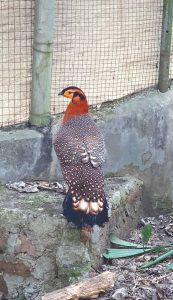Nagaland
Blyth’s tragopan: For Nagaland answer lies in community conservation

Dimapur, July 15 (EMN): In its attempt to conserve the dwindling population of the Blyth’s tragopan in Nagaland, the state government has launched a two-pronged strategy. The part I of this series published in the Monday edition of Eastern Mirror featured the first method of conservation: Ex-situ conservation.
In this edition, we are featuring the second method of conservation, and the challenges ahead as well as the long-term goals for the department of Forest.
In-situ conservation
For in-situ conservation, Aima said that the roles played by the community reserves have given very significant results in the state. According to him, there are currently 93 community reserves notified by the government of Nagaland.
Conservation and community reserves in India are terms denoting protected areas, which typically act as buffer zones or connectors and migration corridors between established national parks, wildlife sanctuaries, and reserved and protected forests of India.
Such areas are designated as conservation areas if they are uninhabited and completely owned by the government of India but used for subsistence by communities and community areas if part of the lands is privately owned. Administration of such reserves would be through local people and local agencies. These protected area categories were first introduced in the Wildlife (Protection) Amendment Act of 2003 − the amendment to the Wildlife Protection Act of 1972.
This type of in-situ conservation plays a major role in conserving the natural habitat of the Blyth’s tragopan and other wildlife species.
There is an understanding between village councils and the department in the agreement. “The agreement is simple: land belongs to you, we will not interfere but you will not be allowed to kill in that area or even cut trees in that area,” explained Aima.
In Nagaland, the area is looked after by a management committee, which comprises of village council members. They also choose representatives among themselves. The team will also consist of one representative from the Forest department who will provide them technical guidance.
The agreement lasts for five years. A booklet is prepared where every activity is defined. “The community sits and work out and then it is sent to the government of India (sic),” he added. Once expired, it depends upon the communities whether to continue with the agreement or not.
The official said that many applications for such reserves are being received from different villages as they are now realising the benefits of conservation.
“The villagers are coming forward to conserve the wildlife as they have realised that it is their resource. They are more than happy that they are benefiting monetarily by conserving and are also benefiting other communities, the state, and the country as a whole,” he said.
The department is continuing to create awareness programmes throughout the state to conserve the bird. Several programmes have also been conducted at Khonoma Nature Conservation and Tragopan Sanctuary. He was positive that such conservation programmes have, and would, eventually increase the tragopan population in the state.
Challenges and long-term goals
The current challenge faced by the department is to get an approximate figure of the number of tragopans in the wild. The official said that “no census about the bird has been taken so far.”
“This is such a shy bird that even if number is more, it is not very easy to see this bird. In the type of forest it lives in, sightings are rare,” he shared.
The census collected will allow the department to device a management programme to initiate necessary steps. It will also help in identifying new species.
“Our problem is to see exactly what is in our jungles, both flora and fauna. It has not been thoroughly recorded about how many species of birds, animals, and plants are found in Nagaland,” he added.
According to the official, the department’s long-term goal is to increase the network of community reserves in the state so that wildlife can thrive.
“You cannot confine wildlife to a small village area as they need lots of space. If many villages start conserving the areas, then a time will come when they will be adjacent to one another. So far, this is the only hope, we feel right now, to conserve tragopan as well as other wildlife species,” he shared.
As boundaries are limitless for these unique animals, Aima believes that Nagaland may have new species, which the villagers might have seen but are yet to be documented by wildlife scientists.
“Once we have sufficient community reserves, we will definitely survey and carry out census. With that data, we will exactly know what we have in our forest. And that will help us with better management in the future,” he shared.

